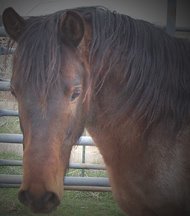Alas, I still look down sometimes. I occasionally forget that it's "elbow, not wrist," too. See?
 But, in the years since I attended weekly lessons, I have learned something Mona never mentioned during all those don't-look-down moments: It's remarkably easy to tell which lead you're on without looking down.
But, in the years since I attended weekly lessons, I have learned something Mona never mentioned during all those don't-look-down moments: It's remarkably easy to tell which lead you're on without looking down.Next time you ride a canter, pay attention to which of your knees shifts naturally forward. That's the lead your horse is on. Every time. Even if you're in 2-point.
That's how I tell, anyway. What's your trick?
_________________________________________________________
Want to read more posts like this one?
Subscribe to The Barb Wire









3 comments:
My style is to ride by feel. I look down but not at the shoulder to see what lead I'm on. I look down because it's a bad habit I have even when walking. I suffer from virtigo so even when I'm not spinning I tend to connect with the ground.
I ride with feel, it iss something one develops and a bit of natural nack helps. I rode my first three horses bareback as my folks required that I earn the money and buy my first saddle. Well It took me a long time because I loved to ride bareback and I spent way more time riding than doing chores. My second horse was a run away named Dusty a Strawberry Roan We ran alot(!!!) even when I didint want to. So as a "trainer" child I decided to teach her leads... if we were going to run then we could run on a lead that agreed with the terrain and circumstances. That mare and that experience taught me a child of about 8 years of age how to feel for the lead because we were going way to fast for my eyes to clear the tears so that I could see what the heck we were doing.
It's fun to go back and remember those wonderful times! Thanks for the stroll down memroy lane.
That's funny, my dressage instructor was talking about the knee trick a few months back when Tom was taking a lesson. It's really very good advice. One of my jumping intructors used to tell me, "if you look down, that is where you will end up". Let's face it, all of us have looked down at one time or another. Once in a while, I think it's okay to take a peek. Just so we don't always do it and become dependent upon it. If I am on a new horse that I am not familiar with sometimes it's hard to tell and I will take a peek at the shoulder. It's not the end of the world.
Along the way at some point, I did learn to ride the canter depart so I knew by feel what lead I was asking for. In a dressage test or an equitation class, the last thing you want is to get caught looking to see what lead your on! Learning by feel was the only way to avoid this embarassment. By focusing on the foot fall of horse's hind legs with your seat, you can feel this relatively easy on most horses. When the outside hind leg is just about coming off the ground and striking forward, give a squeeze with your leg on that same side (outside)to tell the horse to step with some more life. If the timing is right and your horse understands leg aids, you should feel impulsion as he steps come up through your seat and through your seat, that being the lead; outside hind foot; followed by inside hind foot and outside forefoot striking together; and finally the inside forefoot (the leading leg) striking. It takes some practice but with time it clicks and you will find you won't need to look as often. That's my input anyways and what I have found to work, but as with anything else, there is more than one way to skin a cat! Ok - didnt' mean to write a book Sorry!
The mantra of trainer comments that runs through my mind when riding is, "shorten your reins" and "Bend your elbows." I know I need to do those things!
I also use the trick of asking for a canter depart when the outside hind is coming off the ground. I had a trainer who has us call out which foot was coming off the ground until we had a real feel for it. As she explained, you only have a brief moment to influence that leg, so you need to get your timing righ.
Post a Comment